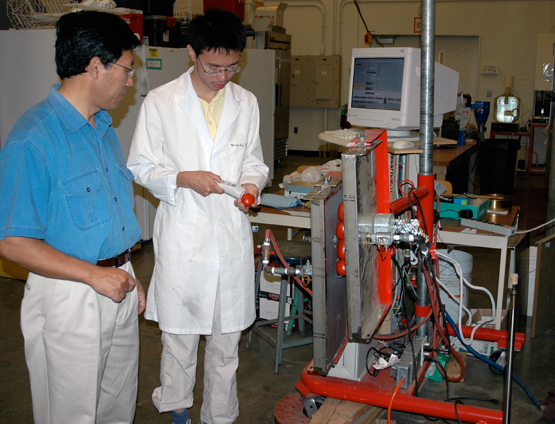Proud to be Green - Fruit and Vegetable Industry Takes Notice, UC Davis Develops New Infrared Peeling Technology

Dr. Zhongli Pan, a Research Engineer for the United States Department of Agriculture – Agricultural Research Service (USDA-ARS) and Adjunct Professor at UC Davis in the Department of Biological and Agricultural Engineering, has developed a new tomato peeling process that's ready to revolutionize the industry.
Pan and his research team, consisting of Griffiths Atungulu (UC Davis postdoctoral scholar), Xuan Li (UC Davis doctoral graduate student), Kathryn Kearns (UC Davis master's student), and others from USDA-ARS, are developing a sustainable alternative to the peeling process of fruits and vegetables using infrared technology – all funded by several grants from the California Energy Commission, California League of Food Processors, California Department of Food Agriculture and other food industry partners.
Using typical processing tomatoes in the lab, Pan peels the tomatoes by using infrared heat rather than lye and steam peeling – the methods that are currently used today in the food industry. Lye and steam peeling methods have many disadvantages, including the use of chemicals and water in the production process, and the need for waste disposal at the end. Pan's infrared method not only eliminates the need for these inputs, it also produces a value-added peel byproduct that can be used as food ingredients or nutraceauticals due to its high fiber and lycopene contents.
Researching at both UC Davis and the Western Regional Research Center of USDA-ARS in Albany, Calif. gave the team a solid start. “The first pilot scale infrared tomato peeling system has been successfully built and tested,” said Pan. During this year's harvest season from July to October they plan to conduct a demonstration for the major food companies – hoping they will implement this new technology and change the face of the food industry's peeling practices.

The team is also in the process of developing another peeling system that can be used for various fruits and vegetables, other than just tomatoes. Expecting to roll this model out at the end of summer, they are on track to hit the food companies with state-of-the-art equipment as well.
Pan and his teams have been working on infrared heating for food processing related research for more than a decade. The revelation of the potential for his work, along with the fact that California produces the most peeled products in the nation, has inspired him to make a global difference. “The ultimate goal of this project is to achieve commercialization of the new sustainable technology to replace the current processing methods,” shared Pan.
This is just another example of what makes UC Davis America's 'Coolest School'.
Pictured Top: UC Davis Professor Zhongli Pan and UC Davis graduate student Xuan Li conduct tomato peeling tests using IR heating at the Food Processing Laboratory in the Department of Biological and Agricultural Engineering, UC Davis.
Pictured Left: Researchers conduct IR dry-peeling tests for tomatoes using a model system. From left to right: UC Davis Professor Zhongli Pan, Dr. Griffiths Atungulu (Associate Project Engineer), Xuan Li (UC Davis Ph.D. graduate student), Carlos Masareje (President of Precision Canning Equipment Co.).
Photo credits: The Zhongli Pan Lab.
